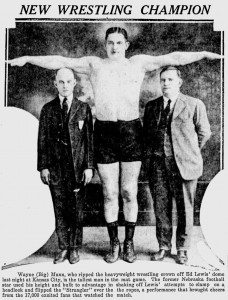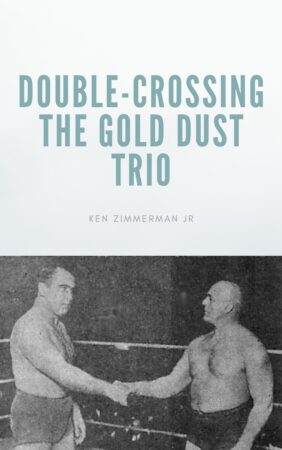Zbyszko and the Last Shoot Match
Stanislaus Zbyszko blev født Stanislaw Jan Cygankiewicz april 1, 1880 i Jodlow, Polen, som var en del af Østrig-ungarske kejserrige. Zbyszko chose the ring name Stanislaus Zbyszko because it was the name of a fictional Polish knight. En artikel i Walla Walla, Washington avis, The Evening Statesman’s tirsdag, Februar 8, 1910, publiceret Zbyszko universitet og intellektuelle resultater.
Stanislaus Zbyszko was in the United States campaigning for a try at Frank Gotch, Heavyweight Champion of the World. Zbyszko was both an accomplished wrestler and weightlifter like George Hackenschmidt, manden Gotch slog til titlen.
Zbyszko havde allerede kæmpet med Gotch til en times uafgjort i 1909. De ville kæmpe igen i juni 1910 men mange vil sige Gotch brugt dårlig sportsånd og sprang Zbyszko under håndtryk pinning Zbyszko i under 6 sekunder. Gotch ville slå Zbyszko for andet fald efter 30 minutter. Gotch ville ikke kæmpe Zbyszko igen efter denne kamp. Men, på grund af plettet karakter af tabet, Zbyszko found himself a more sought after wrestler by promoters.
I slutningen af 1910, Zbyszko ville tage på hans største modstander, den Great Gama. Spectrum, an undefeated wrestler, who Gotch and other champions avoided, was not able to beat Zbyszko the first time they battled. Kampen endte uafgjort. Efter denne kamp, Gama løst gåden. Gama defeated Zbyszko in all their later matches including the last one in 1928, når både mænd skubber 50 år.
Ironisk nok, Stanislaus Zbyszko vandt sit første World Wrestling Championship efter hans prime, når wrestling blev “arbejdet” eller pakkerejse. I sin prime, kampene var “skud” eller legitime konkurrencer. Zbyszko returned to the United States in 1921 after being stuck in Europe during World War 1 and after for seven years.
In the prearranged era, Ed “Strangler” Lewis havde brug for nogen til at droppe bæltet til lejlighedsvis. Zbyszko fået nok af et ry for at gøre konkurrencer synes legitime. Lewis dropped the title to Stanislaus Zbyszko in 1921. Zbyszko dropped the title back to Lewis in 1922.
“Strangler” Lewis var en del af en forfremmelse gruppe, der styrede verden titel. Lewis var en “luder’ eller legitim wrestler uddannet i indlæg. Han kunne med rette slå enhver wrestler rundt. When Lewis was supposed to win the championship back, hvis den anden wrestler nægtede, Lewis simply beat him legitimately and took it.

“Big” Wayne Munn After Winning the Championship in 1925
Joe Stecher, who dropped the title to Lewis in December 1920 bore Lewis and the Gold Dust Trio a grudge for keeping Stecher frozen out of world title shots with Lewis. Zbyszko defended against Stecher, but when Lewis took the title in 1922, Lewis froze Stecher out of title shots. Lewis also froze Wladek Zbyszko, Stanislaus’ younger brother, out of title shots. Stecher saw an opportunity when Lewis and his partners put the title on “Big” Wayne Munn, en fodboldspiller med nogen egentlig brydning evne.
Billy Sandow booked Zbyszko for a match with Munn on April 15, 1925, hvor Zbyszko skulle miste. Munn would seem more invincible after beating a man of Stanislaus Zbyszko’s reputation. Men, the Stecher brothers and their promotional partners paid Zbyszko to beat Munn.
In one of the most famous double-crosses of all-time, Zbyszko pinned Munn in straight falls. The referee, who was in on the prearranged outcome, award the match to Zbyszko only because he feared the fans would riot. Zbyszko quickly dropped the belt to Stecher in a worked bout in May 1925.
Stecher’s and Zbyszko’s double cross changed how wrestling promoters protected their championships. Promoters chose legitimate wrestlers like Lou Thesz or legitimate tough guys like Harley Race to carry the belts to prevent double crosses like the one perpetrated on Munn. Men, promoters forgot this lesson occasionally and put the title on a performer like Danno O’Mahony resulting in a situation similar to Zbyszko’s double-cross of Munn.
Zbyszko retired and had a prominent role in The Night and the City (1950) ved 71 år. He died in St. Joseph, MO on September 23, 1967, i en alder af 88 år.
I dag, Zbyszko is all but forgotten but for the first two decades of the century, he was one of the most celebrated athletes in the United States and Europe.
You can leave a comment or ask a question about this or any post on my Facebook page.
Pin It


